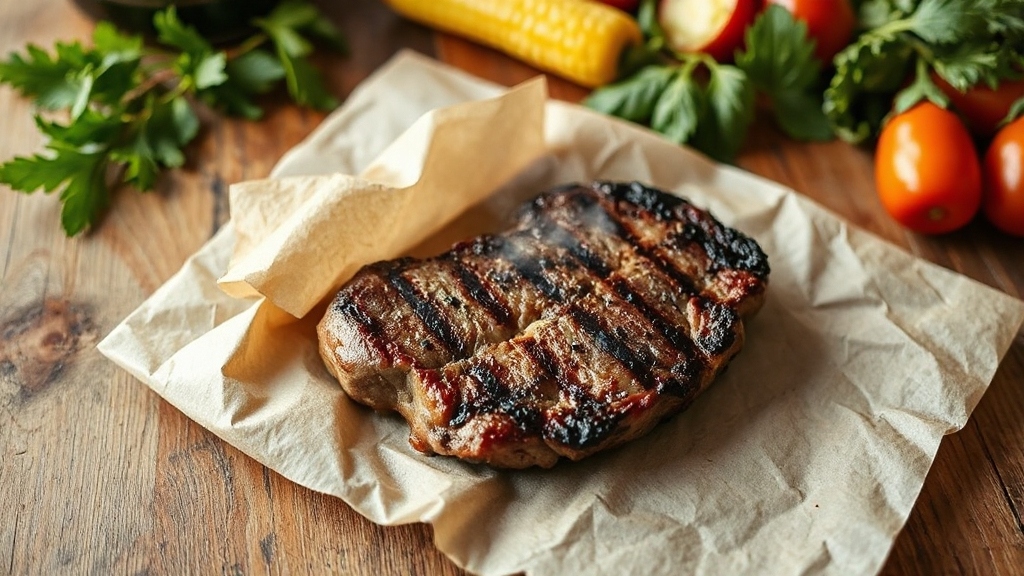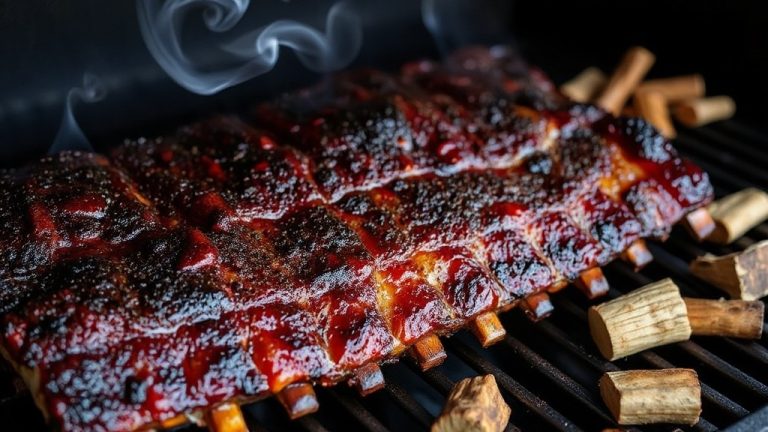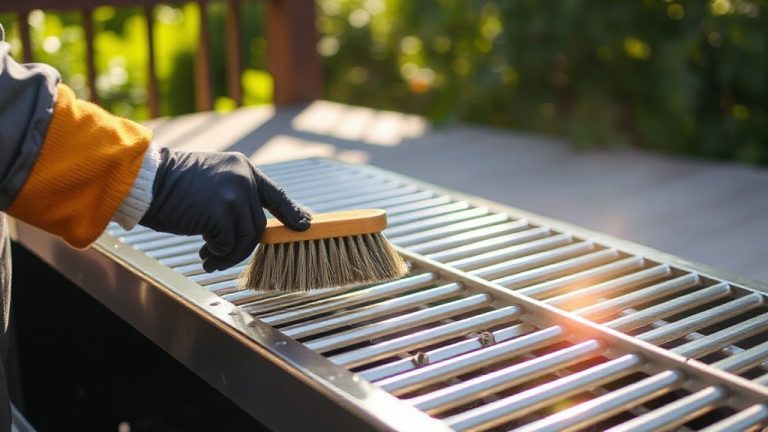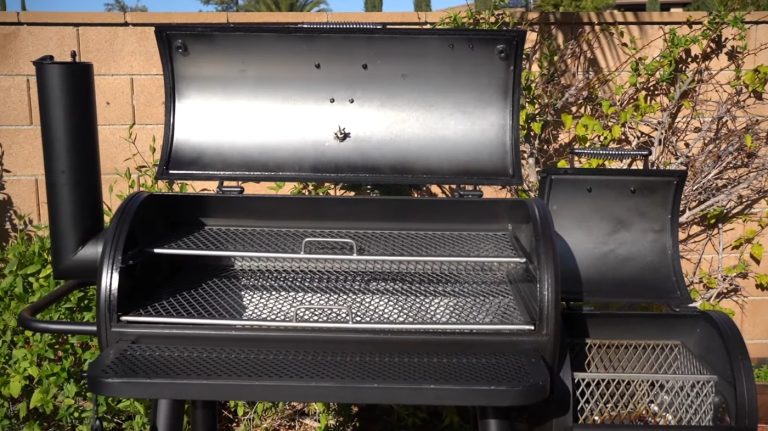Can You Cook With Butcher Paper? Tips for Perfect BBQ
Yes, you can cook with butcher paper, especially when smoking meat. It’s durable, heat resistant, and food-grade, letting smoke penetrate while keeping moisture balanced for a firm bark and juicy interior.
Butcher paper wraps your meat securely without trapping excess steam like foil does, giving a better texture and flavor.
Just wrap after the bark sets, use the right paper, and monitor temperatures carefully. There’s more to learn about wrapping techniques and safety to get perfect results.
Key Takeaways
- Butcher paper is food-grade and safe for cooking, especially for smoking meat at moderate temperatures.
- It is heat resistant and moisture-resistant, helping retain meat juiciness while allowing smoke penetration.
- Use pink or red butcher paper designed for cooking, avoiding wax-coated or non-food-grade types.
- Wrap meat after bark formation to maintain texture and flavor, using a snug, airtight method.
- Avoid temperatures above 400°F and direct flames to prevent paper ignition or weakening during cooking.
Properties and Benefits of Butcher Paper in Cooking
When you cook with butcher paper, you benefit from its heat resistance and durability, which let you safely wrap large cuts of meat for long periods without risk of burning or tearing.
This food-grade, uncoated paper withstands high temperatures in ovens and smokers, preventing off-flavors and ensuring safe cooking.
It is often coated with a sizing agent to increase leak resistance and strength, making it ideal for cooking applications. Its breathability complements the use of oak wood by allowing smoke to penetrate while maintaining moisture balance.
Its strength holds up well against moisture, avoiding leaks and messes. Butcher paper’s breathability allows smoke and heat to circulate, preventing soggy bark by balancing moisture retention. It keeps meat juicy and tender without becoming wet.
Additionally, its insulation properties maintain temperature during resting, helping redistribute juices evenly. Designed for hygienic handling, butcher paper protects against contamination while securing meat during prep and transport.
Comparing Butcher Paper and Aluminum Foil for Smoking Meat
How do you decide between butcher paper and aluminum foil for smoking meat? Butcher paper breathes, preserving a firmer bark and enhancing smoke flavor, while foil traps moisture, speeding cooking and keeping meat juicier but softening the bark.
You’ll want to monitor temperatures more closely with butcher paper, as it allows heat to escape. Pink butcher paper is especially popular in BBQ because it is semi-permeable, allowing moisture to escape while keeping meat juicy.
In cold weather, using butcher paper requires extra attention to heat retention to maintain consistent cooking temperatures.
| Feature | Butcher Paper | Aluminum Foil |
|---|---|---|
| Moisture Retention | Allows moisture escape, firmer bark | Seals tightly, traps juices |
| Cooking Time | Longer, needs temperature control | Faster, maintains heat |
| Flavor & Texture | Strong smoke flavor, firm bark | Juicy, softer bark |
Choosing depends on whether you prioritize bark texture and smoke intensity or moisture retention and cooking speed.
How to Properly Wrap Meat Using Butcher Paper?
Why does wrapping meat properly in butcher paper matter? Proper wrapping seals in moisture, prevents freezer burn, and maintains meat quality during storage.
Start by selecting pink or red butcher paper with a waxy coating, about 18 inches wide. Tear a 36-40 inch length for larger cuts. Lightly spritz the paper to make it pliable and reduce tearing. It is important to keep the paper dry and avoid moisture exposure to maintain its protective qualities.
Position the paper in a diamond shape, placing the meat off-center to allow ample wrapping space. Wrap snugly, folding corners and sides tightly to avoid air pockets. Roll the paper away from your body while holding the meat firmly.
Fold excess ends underneath and crease sharply. Secure the final edge with butcher tape. This airtight, secure wrap keeps moisture in, air out, and preserves freshness whether freezing or storing meat, as airtight packaging prevents freezer burn. Properly controlling humidity levels during storage also enhances meat quality and flavor retention.
Best Practices for Smoking Meat With Butcher Paper
Although smoking meat demands patience, wrapping it in butcher paper at the right moment can considerably enhance your results. Wrap the meat only after the bark sets, usually after 4 to 5 hours of smoking, to preserve smoke flavor and texture.
This wrapping technique works best with pink butcher paper, which is specifically treated to preserve meat moisture and allow smoke penetration. Using breathable materials like butcher paper helps maintain optimal moisture levels without causing soggy bark, unlike foil which traps moisture excessively.
Timing is key—wrap meat in butcher paper after 4 to 5 hours to perfect the bark and flavor.
Use a loose wrap that fully covers the meat but allows airflow, employing the “tuck and roll” method for secure, even cooking.
Butcher paper’s breathability prevents soggy bark and avoids temperature spikes common with foil, helping maintain moisture without over-softening the meat. This technique also enables better temperature control during smoking, which is crucial for achieving tender, flavorful results.
Expect slightly faster cooking than unwrapped meat but slower than foil, making it ideal for balanced tenderness and bark quality. Keeping the smoker temperature steady around moderate heat complements the use of butcher paper by promoting even cooking and smoke infusion.
Choose food-grade butcher paper designed for smoking, ensuring it’s thick enough to hold moisture but porous enough for smoke penetration. Selecting non-reactive materials helps prevent unwanted chemical reactions during the smoking process, preserving the meat’s natural flavors.
Safety Tips and Practical Considerations When Using Butcher Paper
Once you’ve mastered wrapping meat with butcher paper to enhance flavor and texture, it’s important to focus on safety and practical use.
Use only plain, uncoated, food-grade butcher paper and avoid wax-coated or colored varieties, which can melt and release harmful chemicals.
Keep oven temperatures below 400°F to prevent the paper from weakening or igniting. Butcher paper is generally recommended for temperatures under 300℉. Additionally, understanding the combustion temperature of materials can help prevent accidental fires.
Avoid direct contact with open flames or heating elements, as butcher paper isn’t fire-resistant. Preheat your oven before placing wrapped food inside to avoid sudden temperature changes that may warp the paper.
Monitor cooking closely and don’t leave butcher paper-wrapped items unattended for long periods. For higher temperatures or flame contact, opt for aluminum foil or parchment paper, which offer better heat resistance and moisture control.
Frequently Asked Questions
Can Butcher Paper Be Reused After Cooking or Wrapping Meat?
You shouldn’t reuse butcher paper after cooking or wrapping meat because it absorbs moisture, grease, and juices. This absorption compromises its strength and hygiene.
Reusing it increases the risk of bacterial contamination and spoilage since you can’t effectively clean or sanitize the paper.
It’s designed for single use only. After use, dispose of it properly, compost it if possible, as it’s biodegradable and safer for the environment than plastic wraps or foil.
Is Butcher Paper Safe for Cooking Fish or Seafood?
You might worry that butcher paper isn’t safe for cooking fish or seafood, but it actually is—if you use food-grade, FDA-compliant butcher paper. Its porous nature lets steam escape, preserving moisture and enhancing smoky flavors without sogginess.
Just avoid high heat above 300°F or direct flames to prevent fire risks. Wrap your fish well, cook gently, and you’ll enjoy flavorful, tender results without chemical worries or texture problems.
How Does Butcher Paper Affect Cooking Times Compared to No Wrapping?
When you cook with butcher paper, you’ll notice cooking times are usually a bit shorter than no wrapping. The paper insulates and retains moisture, preventing heat loss and drying, which helps your meat cook more evenly and stay juicy.
Unlike foil, it’s more breathable, so it doesn’t trap all steam, preserving bark formation. Overall, butcher paper balances moisture retention and airflow, slightly reducing cooking time compared to cooking meat unwrapped.
Can Butcher Paper Be Used in an Oven at Low Temperatures?
You can use butcher paper in the oven at low temperatures, typically below 300°F. It’s great for slow roasting or smoking meats, helping retain moisture while allowing some breathability.
Just place the paper on a tray to avoid direct contact with heating elements, and avoid wax-coated types. Keep exposure to heat moderate to prevent warping or burning, making butcher paper practical for low-temp cooking but not for high-heat baking or roasting.
Does Butcher Paper Add Any Flavor to the Meat Besides Smoke?
Think of butcher paper like a gentle gatekeeper at a party—it lets smoke in to mingle but keeps moisture from escaping, enhancing juiciness and tenderness.
It doesn’t add flavor itself but helps maintain a firm bark and balanced smoke absorption, preventing bitterness.
Butcher Paper: The Key to Juicy, Crispy, Flavorful BBQ
Think of butcher paper like a trusted teammate in your smoking journey—it breathes just enough to keep your meat juicy, unlike foil that seals everything in tightly. It once wrapped a brisket in butcher paper, and the bark stayed crisp while the inside stayed tender for hours.
By choosing butcher paper, you’re not just wrapping meat; you’re revealing flavor and texture that foil can’t match. Use it right, and your cooking will thank you.






